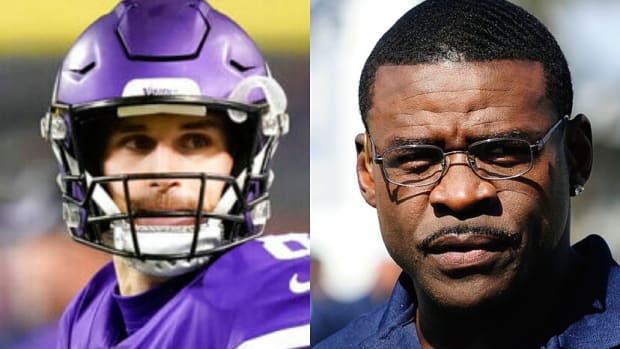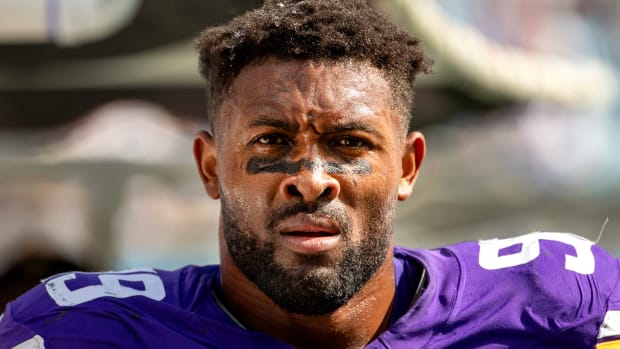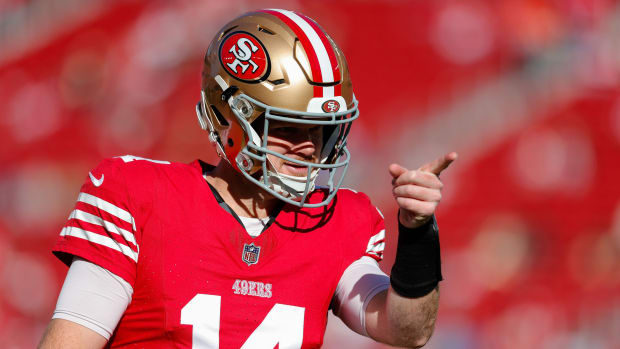Offseason Roster Question No. 3: How Can the Vikings Improve Their Offensive Line?
In what feels like an annual tradition, the Vikings enter the 2020 offseason in need of an upgrade to their offensive line.
While Kirk Cousins and Kevin Stefanski deservedly took some heat for the Vikings' season-ending loss to the 49ers, their jobs as quarterback and play-caller were made almost impossible by the play of the o-line. With a pass-block win rate of 38.5 percent that was far and away the worst of the weekend, the line rarely gave Cousins time to find receivers downfield. It also failed to create any holes for Dalvin Cook, a combo that made it exceedingly difficult for Stefanski to find ways to beat the 49ers defense.
For much of the year, the Vikings' offensive line was decent to below average, though it ranked consistently better in run-blocking than pass-blocking. But in a handful of games against teams with outstanding pass rushes, the line gave out completely. There were bright spots and reasons for optimism going forward, but it's still a unit the Vikings absolutely need to address before next season.
For the season, the line's pass-block win rate of 57 percent ranked 23rd in the league, and their PFF grade was 19th. It wasn't the worst Vikings o-line in recent memory, but that doesn't mean it was particularly good. Still, Mike Zimmer believes the group improved in 2019, and has a chance to continue to do so in the future.
"I think they improved quite a bit," Zimmer said. "I think [OL coach] Rick Dennison did an outstanding job with them. I think the scheme helped them. I thought that was a good group. I think we’ve got some young guys that we basically redshirted this year that I think are going to have opportunities to be good football players. I’m hoping that becomes even more of a strength for us next year, and we’ll be looking to continually try to improve not just that position, but all of them."
The specific area that must be addressed is the left side of the line. In the third season of a five-year, $59 million deal, left tackle Riley Reiff was the same solid but unspectacular player he has been since joining the Vikings in 2017. Considering what he's being paid and the importance of the left tackle position, his production hasn't been quite good enough. The most obvious starter the Vikings need to replace is left guard Pat Elflein, who hasn't shown any real upside as a pass-blocker in his first three NFL seasons.
Rookie center Garrett Bradbury had more downs than ups in his first NFL season, finishing with PFF's worst pass-blocking grade of any center in the league, but he was a key piece in the running game and the team still believes in his overall upside. Right guard Josh Kline had a solid season and figures to remain the starter next season. The best player on the offensive line is probably already right tackle Brian O'Neill, who has been very impressive in his first two seasons.
Considering the Vikings could save $8.8 million in 2020 cap space by releasing Reiff, it wouldn't be a surprise if the team moves on from him and begins the search for a new left tackle. Reiff could also potentially stick around and be moved to guard to replace Elflein. The Vikings could move O'Neill to the left side, but with how well he's played at right tackle, that might be an unnecessary risk. 2019 rookies Dru Samia (guard) and Oli Udoh (tackle) are the redshirted players Zimmer was referring to, and both figure to compete for starting spots next season. The Vikings will also undoubtedly look to bring in both tackles and guards from outside the organization to help improve the line.
With the salary cap-troubled Vikings unlikely to be a player for major o-line talents in free agency, upgrades will probably have to come from minor signings (a la Kline last offseason) or the draft. The latter is slightly concerning, because for all of Rick Spielman's success in drafting defensive and skill-position players, he has struggled to hit on offensive line selections during his tenure as general manager.
Spielman's first selection after taking over in 2012 was USC tackle Matt Kalil at No. 4 overall, which was a flop. He then went four straight years without selecting an offensive lineman in the first three rounds, before doing so in each of the last three drafts. Of those three, Elflein (2017 third round) was a bust, O'Neill (2018 second round) looks like a home run, and Bradbury (2019 first round) is TBD. None of Spielman's 11 late-round offensive line selections – a group featuring the likes of David Yankey, TJ Clemmings, Tyrus Thompson, Willie Beavers, and Danny Isidora – have turned into productive NFL players, though Samia and Udoh could still change that.
Though cornerback and three-technique defensive tackle are both also major needs, it wouldn't be shocking to see the Vikings select an offensive lineman in the first round for the second straight year. Tackles Isaiah Wilson (Georgia) and Mekhi Becton (Louisville) have both been mocked to the Vikings at pick No. 25.
Regardless of how it happens, there will be changes on the offensive line. Piecing together that puzzle successfully could be the key to the Vikings' offense unlocking its full potential under a new coordinator in 2020.
The Vikings offseason roster questions series is a deep dive into the biggest decisions facing the Vikings as they look to upgrade their roster in 2020.
Question No. 1: Is Kirk Cousins the Future at Quarterback?
Question No. 2: Should the Vikings Spend Big on Dalvin Cook?
Question No. 3: How Can the Vikings Improve Their Offensive Line?
Question No. 4: Who Stays and Who Goes in Vikings Secondary?





